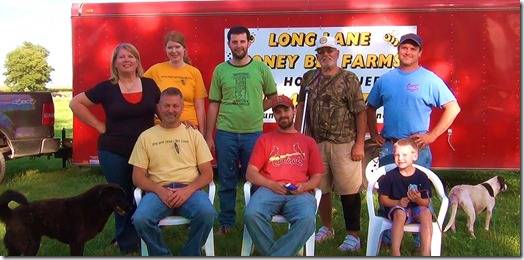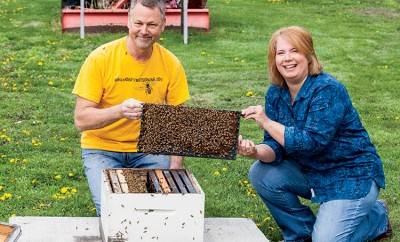Roughly thirty miles from Champaign, David Burns and his wife Shari offer educational programs on beekeeping that attract apiary enthusiasts from around the country.
 Burns, a certified master beekeeper, began keeping bees in 1994. He currently maintains ten hives for educational purposes and offers dozens of courses a year on topics ranging from basic beekeeping to cultivating queens to keeping bees in winter. His courses are offered at Long Lane Honey Bee Farms in Fairmont, Illinois. Many beekeeping resources — including videos on basic beekeeping topics and a podcast of beekeeping information — are available on his website. His courses, which are all capped at 20 participants, attract all levels of beekeepers, from novice to expert.
Burns, a certified master beekeeper, began keeping bees in 1994. He currently maintains ten hives for educational purposes and offers dozens of courses a year on topics ranging from basic beekeeping to cultivating queens to keeping bees in winter. His courses are offered at Long Lane Honey Bee Farms in Fairmont, Illinois. Many beekeeping resources — including videos on basic beekeeping topics and a podcast of beekeeping information — are available on his website. His courses, which are all capped at 20 participants, attract all levels of beekeepers, from novice to expert.
I chatted with Burns a few days ago to learn about how he approaches beekeeping.
Smile Politely: You’re obviously very passionate about bees. Why?
David Burns: I started keeping bees as a hobby. I liked getting a bit of honey now and then. But then it gets in your blood. I started thinking, “I love bees.” And then I started thinking about how we really need bees. One out of every three bites of food comes from the pollination process. I think we need to increase the population of honeybees so we can have better food. My wife Shari and I got really passionate about helping others learn more about beekeeping. I took years of studying to become a certified master beekeeper. But finding ways to keep bees alive is important to us because we want to see more bee populations. When I was growing up in the 60s and 70s, there were bees everywhere. You just don’t see that anymore, and that’s really sad. We need honeybees, and we need beekeepers to keep them. We’ve dedicated our lives to that.
SP: What is the bare minimum in terms of resources and land that people need to keep bees?
Burns: Anybody can keep honeybees. It’s a bit different to keep bees now than it was in the 60s and 70s because there are more diseases. But it’s not impossible; it’s just challenging. First, you need to take a class. There’s nothing like talking to a knowledgeable person about bees and hearing them explain what you need to do. As far as property, you have to check with your local city or town to make sure beekeeping isn’t banned, but for the most part that’s not the case. In terms of property size, bees fly up to three miles away to gather pollen and nectar. It would be rare for them to stay close to home and spend all their time at your neighbors’ place. They fly all over town doing what they’re supposed to be doing. So you don’t need a lot of space to keep bees. I have customers from major cities like Chicago who keep bees on their balconies. They have a very small footprint in your backyard.

SP: How long do you need to keep bees before you can harvest honey?
Burns: The easy answer would be to not expect any honey the first year, but definitely by the second year you can expect honey. However, in a perfect scenario with lots of nectar sources, you can collect honey in the first year. I’ve had some customers collect 200 pounds of honey their first year. If it happens to be a rainy season, bees aren’t able to go out and get as much nectar, so they won’t produce as much money. But few years ago we had a drought, and every beekeeper had an enormous amount of honey. Bees are very good at going out and finding floral sources, so even if it’s dry, they can still produce lots of honey. The average honey yield in Illinois is about 70 pounds per year.
SP: Are there any particular challenges or benefits to keeping bees in this area of the country?
Burns: This is a nice area to keep bees. In the southern states, they have a short nectar season. But here, our pollen season begins in late March or early April, goes all the way through August, and picks up again in the fall with goldenrod and asters. But Illinois has really hard winters. We are on the plains with strong winds, low temperatures, and high wind chill factors. Bees survive just fine in the winter provided they’re healthy. They are typically at risk if they’re low in numbers, low in food source (the beekeeper took too much honey or they didn’t produce enough), or if they have viruses.
SP: What can non-beekeepers do to support bee populations?
Burns: First, they can start keeping bees. That will bring up to population. It’s amazing how many people are getting into keeping bees because they want an alternative sweetener or they are going back to sustainable lifestyle. Honeybees are riding on the bandwagon of the locavore movement.
Second, people can use common sense about not killing everything bees live on. Don’t kill every dandelion and every extra flower in your lawn, because bees feed off of them. I tell people that here in Illinois, it’s not so much the fact that so many farms raise mono-crops, or even the pesticides they use on mono-crops — what’s really bad for bees is products like Round Up. Most studies show Round Up doesn’t kill bees, but it does kill what bees eat. Bees don’t feed on field corn pollen, and they’re not that interested in soy beans, so here in Illinois you have all these acres of land that don’t have typical nutrition. People who aren’t farmers can help by not mowing everything down — for example, by letting clover flowers in your lawn bloom for a week before mowing. Another bad thing about residential sprays is that bees can actually get it on themselves and go back and feed it to other bees, which can kill the entire hive.
One thing a lot of people don’t know is that starting in the late 1980s, a type of mite came to America that has ravaged bee populations. It wiped out almost every beehive there was. It’s still the biggest problem in beekeeping. These mites are in every hive; they reproduce in every colony, and they can have well over 20 viruses. Bees are suffering from the viruses these mites spread, and many beekeepers don’t do anything about it. It’s actually hard to convince beekeepers to control them. I think it’s unfair when beekeepers say “all these chemicals are killing my bees,” but they don’t know about the mite levels in their hives. If you’re controlling your mites, if you have less than a 3% mite load in your whole hive and your bees are still dying, then you might blame chemicals or cold winters. But I don’t think it’s fair to blame others if you’re not keeping your mite population down. In our courses, we teach a four-part principle for controlling mite populations that doesn’t involve chemicals.

SP: What classes do you have coming up?
Burns: Our bee institutes are sold out. Our overwintering classes will be taught in August. Those classes are really exciting. I’ve paged through all the science and researched all the techniques on how to protect your bees from winter, and from that I created a class to help people prepare their hives for winter. A honeybee only lives 30-45 days in the summer, but when a bee is born in late fall, they live 4 to 5 months, so it really is a whole different physiology. What I try to teach is that you have to get through the winter with new bees that are healthy rather than old worn out foragers. Once I get that across, people have so much more success in getting their hives through the winter. Our next basic beekeeping class will be offered in October.
Long Lane Honey Bee Farm is located 14556 N. 1020 E. Road in Fairmont, Illinois. Registration for beekeeping courses is available here.








